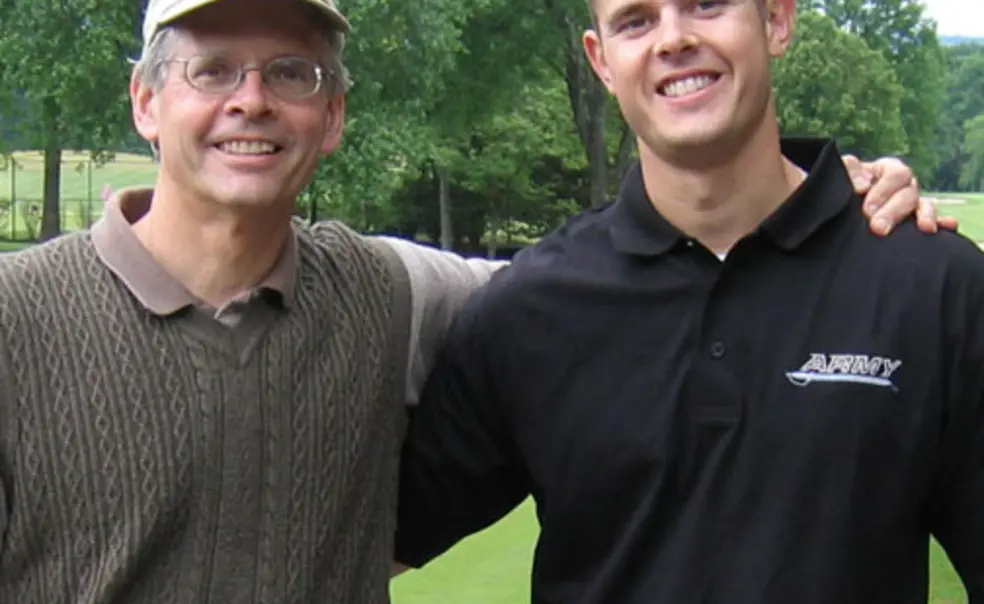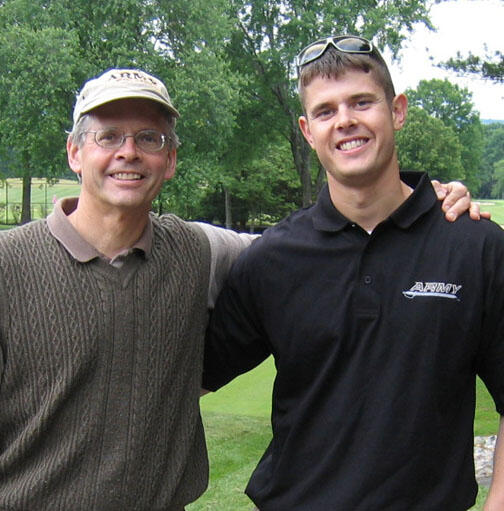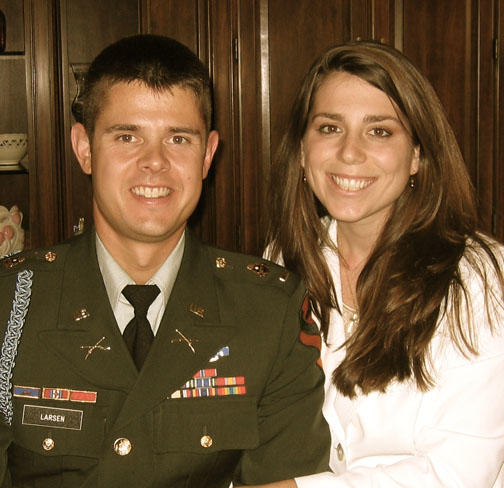The wounds of war
Mark Larsen '76 tells of the pain, scars, and lessons learned after his eldest son was shot in Iraq.
Early in the morning of Aug. 17, 2007, while I was at home, a call came from my lovely daughter-in-law, Jessica. “Chris has been shot in his hands; I don’t know how badly he has been hurt, but he has had surgery in the Green Zone.”
Our son, Christopher, had deployed to Iraq as a second lieutenant 10 months earlier after receiving extensive leadership and other military training following his four years at West Point. We were all aware of the potential dangers. When we had hugged him goodbye at Fort Hood, Texas, in late October 2006 as he left for Iraq, I felt a part of my life was being taken away. Every morning after that, I awoke wondering where he was and how he was. I tried to avoid much contact with the latest Iraq news except the stories of those who had died or been injured, and the list of names that too often appeared in The New York Times.
As each day went by, as Thanksgiving, his birthday, Christmas, Easter all passed, I began to believe that he would get through this safely. President Bush’s decision to extend all of the troops’ deployment by an additional 90 days – to 15 months – was hard to take, knowing that his exposure to the dangers of war only would be multiplied. And while Chris initially had been offered a desk job in the Green Zone, he had refused it, and asked to be a platoon leader. And that is how he ended up being based at Camp Liberty, a concrete mini-fort housing four platoons (130 men) about 20 miles west of Baghdad.
So as I tried to digest Jessica’s news about my eldest son, I slowly made my way to our bedroom to wake my wife, Cynthia, and tell her about Chris. It was a difficult talk, as I could not answer her questions, but her strength was evident even then. I climbed the stairs to where our other two children were sleeping, woke them, and made them aware of Chris’ situation. We all cried, and then we prayed.
Not knowing how badly he was hurt or where he would be taken, I tried to reach out to contacts who could help. One was able to track down two of his friends in the Green Zone who made their way to the hospital and got a nurse there to take a photo that was e-mailed to us within 24 hours. We could see Chris’ face and his upper body, as well as his totally bandaged hands and arms. A few fingers were evident, but we were not quite sure how many. How much damage to his hands, wrists, and arms? What would happen next? In the Army, a famous phrase is “Hurry up and wait,” We tried to balance our concerns for Chris with the reality that this situation was totally out of our hands. I tracked down the e-mail address of Jonathon Jaffin ’78, who had gone on to pursue a medical career via ROTC and had risen to great heights at Walter Reed Hospital. He now was the head of the group of 4,000 physicians who serve in the military around the globe. Although he was vacation, he called to assure me that he would do all he could to help us out with Chris.
Meanwhile, Chris was on the move. He had been taken to Balad in northern Iraq after 12 hours, had additional surgery, and then was being flown to Germany. We had no idea of any of this until I called the Red Cross number given to all families of deployed troops and explained to the volunteer on the other end of the phone that I was trying to find out where my wounded son was. “Give me 30 minutes and I will call you back,” he reassured me. And he did just that. He confirmed that yes, Chris had been flown to Germany, and then he surprised me by saying, “Would you like to speak with him?”
I could hardly spit out “yes” before the line was ringing. I was afraid that Chris would not be able to pick up the phone, given the condition of his hands, and sure enough a sweet female voice answered, asking, “How can I help?” I then held the phone while I struggled with what to say to Chris. Just hearing his voice was reassuring, although I could tell he was in great pain and also fully medicated.
By now 48 hours had passed; he had gone through four surgeries in three different places, and we still had no idea what would happen next. Would he eventually end up at Walter Reed, or another place I had not heard of before, Brooks Army Medical Center in San Antonio?
Brooks Army Medical Center, we were soon to learn, is the premiere burn and trauma center in the United States and probably in the world. We scrambled to find six tickets to Texas as I was determined that all of the Larsens should go to meet him, as well as Jessica and her mom, a former trauma nurse.
When you walk onto the Brooks Army Medical campus, you literally are struck by the pain and hurt of war; you see young people who are missing limbs, but valiantly are trying to walk or even run. You see the visible scars of war as well as feel them; at the same time you are humbled by the strength and dedication of those around you – surgeon, nurse, patient, parent, or support group. The scars are real, they can be lifelong, and 99 percent of Americans are totally removed from them.
You also are struck by the generosity of Americans who have given millions to help the Fisher House program provide shelter for military families whose lives have been traumatized by the wounds inflicted on their loved ones, who had to drop everything to travel to Texas to be there, to help, to heal. And the 600,000 Americans who have donated to build the Center for the Intrepid, the rehabilitation center on the Brooks campus where miracles occur daily.
By Tuesday afternoon we were in San Antonio, aware that Chris was on a hospital plane with a couple of dozen of wounded soldiers, flying on the daily non-stop from Germany to Texas. We were at the Brooks emergency room, pacing around, when the injured and burned soldiers finally arrived that evening. It was so quiet in that space as they wheeled each soldier on his bed into the main hospital, one by one in order of greatest medical need, most with no family member present, into the place that would try and put their bodies and their lives back together.
Then we saw Chris, with his infectious big smile but unable to hug or hold anyone or anything. His pain was excruciating; he could not hold a spoon, wash himself, or dress himself. The next day he told us how he had been wounded in a gun battle after they had discovered bad guys planting IEDs. He was in the firing position when the bullet came through his left hand, down the body of his rifle, through his magazine, his right-hand ring finger, palm, and then out his right wrist. An inch higher and he would have been hit in the face....
But he was alive, and, with the exception of one of his fingers, everything else appeared to be intact.
Over the next 48 hours he had two more surgeries, and within a week he was an outpatient living at the Fisher House on campus.
By October he could hug us, and his left hand and wrist appeared to be on the way to healing well. But at Christmas we discovered that he was burning his left hand on the toaster and not feeling it. As hands involve lots of bones, nerves, and tissues, we were aware that the shock of the gunshot could sometimes stun the nerves for weeks or longer, but something seemed suspicious. I connected with Gregg Goldstrohm, a hand surgeon who as a high school classmate and friend had been advising us since the time Chris was wounded. The day after Christmas we drove out to see Gregg, and within five minutes he diagnosed that Chris’ median nerve had been severed and would require a nerve graft.
Six weeks later Chris was in the hands of a world-renowned hand surgeon, who took 10 inches of his calf nerve and grafted it into the dead nerve area. Nerve can regenerate at a speed of one inch per month, and within a couple of months, Chris was feeling tingles in the palm of his hand. The more difficult surgery had to wait until June 2008, when he received a wrist bone graft. Fusion of the wrist was the only other option, but if the graft takes, it should give him 30 to 40 percent movement of his right wrist.
More than 4,000 of our soldiers have died in Iraq and more than 35,000 have been wounded; countless others have or will have lifelong challenges from issues like PTSD, let alone the physical wounds of war.
Chris is lucky; the nerve in his left hand has nearly made it to the top of his fingertips, and he probably will be able to use (and feel with) his left hand much of what you and I do. There is less certainty with his right hand, but we will know more after five or six more months of daily rehab. He currently has about 22 percent movement in his right wrist. While there has been much pain for Chris, his wife, and his family, there also have been many moments of great joy. He has relearned that the heart is the most important muscle you have, and for a 6-foot 2-inch, 200-pound Division I lacrosse player, that is an important lesson we all should not forget. We also been fully reminded daily of the incredible power of love and prayer, as well as of science and medicine.
Chris was also lucky in that while he probably won’t be able to shoot a lacrosse ball 90 miles an hour, he will be able to live a fairly normal life. Also, we were able to drop everything to be there for him for many months.
If you are feeling generous and want to help a wounded soldier or their family out, I encourage you to give to Fisher House (fisherhouse.org) or the Wounded Warrior Project (woundedwarriorproject.org), which assists servicemen and servicewomen who have been severely injured. If you have the time, give some of that priceless commodity to these and other great causes to help heal the wounds of this unfortunate war.
Mark Larsen ’76 is president, Asia-Pacific and Global Nutritionals, for Wyeth Pharmaceuticals. A native of North Dakota, he came to Princeton on a scholarship for which, he says, he will be “forever grateful.” He is married, has two other children in addition to Chris, and lives in Princeton.














No responses yet